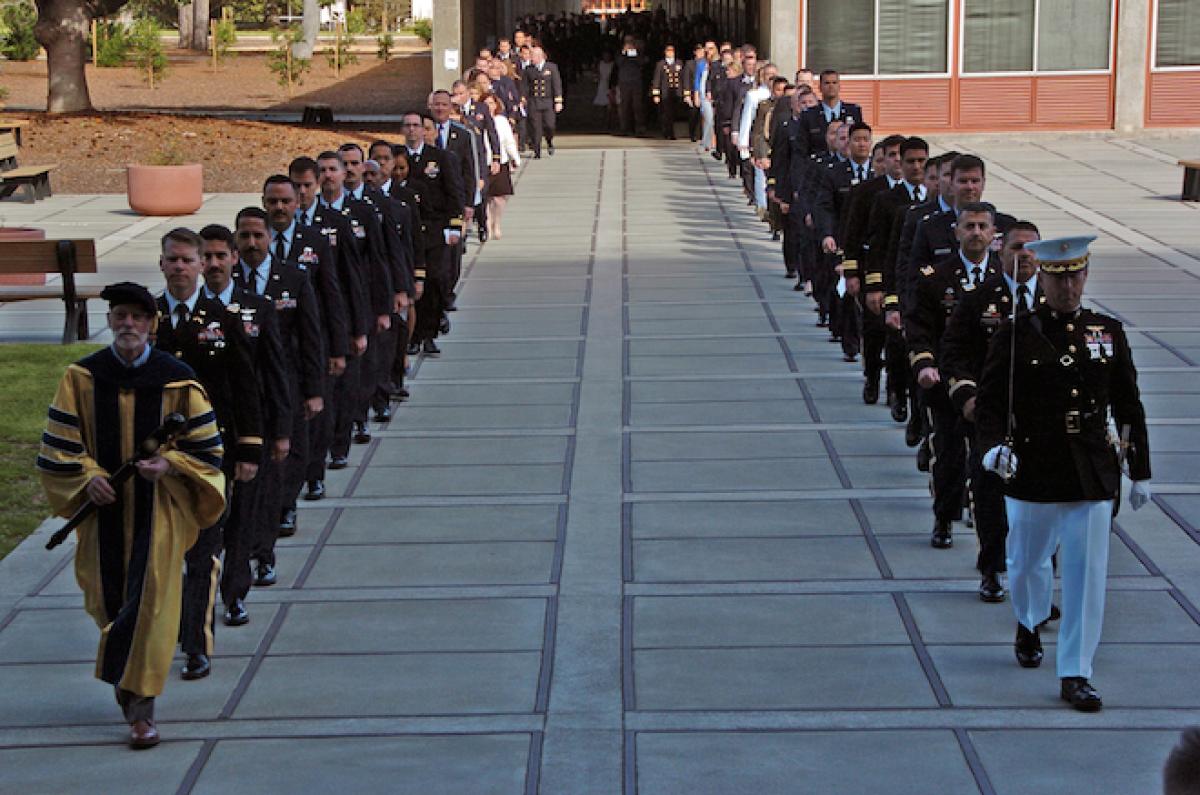 “Today’s security environment merits a different approach. Strategic frameworks must align to the realities of strategic environments. You can’t impose a strategy on a strategic environment; you need to derive strategy from it.”
“Today’s security environment merits a different approach. Strategic frameworks must align to the realities of strategic environments. You can’t impose a strategy on a strategic environment; you need to derive strategy from it.”
– Vice Admiral T. J. White, Commander Fleet Cyber Command/U.S. Tenth Fleet, at 2019 Naval Postgraduate School Fall Graduation
There is a false choice in front of the Navy regarding educating its future leaders—does it teach strategy or just science and technology? At the graduate school level, does it choose STEM majors over strategy majors? These “either-or” questions derive largely from a persistent bias that these areas of study are separate matters for the professional mind. Yet, the applied intellectual activity of naval leaders is fundamentally a hybrid of both, so a “both-and” approach is more useful. Invention and innovation in propulsion technologies and systems over the centuries have had an enormous impact on maritime capability and the strategic positioning of naval forces.
As stated in the Department of the Navy’s 2019 Education for Seapower report: “From a long study of war, we know that leaders in peace, crisis and conflict must be able to accomplish three things: discern, decide and act.” Discerning requires the application of expertise and knowledge, as well as the ability to think critically and holistically (about, for instance, where the strategic environment is going and how competitors and opponents perceive and think). Decision-making and acting require insights, judgment, and perspective regarding operational and strategic impact and consequences, both intended and unintended. These three things are not separate and distinct parts of a whole. They are a matrix of intersections inside the intellectual competence of individuals, teams, and organizations. Ideally, a strategic-technical mind-set is required—one that should be ingrained in any individual, group, or organization that desires to have impact.
A fully integrated and diverse workforce is becoming a reality within the most creative organizations. A balance of diversity and integration increasingly underpins the most sustainably successful endeavors. In fact, an organization’s structure, culture, and imperatives have important technological and strategic perspectives. Noting Admiral White’s observation, technological competence is advantaged by understanding how science and technology lead and link to all other things in a given environment, including the strategic environment.
The concept of the essential link between technology and strategy is not new to the military. The current challenge is that its workforce perspective is often too driven by the rational, quantitatively derived solution—the output of an industrial age bureaucratic approach to education, classification, identification, and personnel management. Unifying and organizing for the cognitive age will require a much different approach.
Leveraging the nexus between technology and strategy requires understanding human behavior within the context of various environments. As Naval Postgraduate School (NPS) distinguished computer science professor Dr. Peter Denning has noted: “Technology is tools and equipment that support human practices. Technology often opens new possibilities that we can follow. What looks like ‘technology driving’ is humans making choices.” Any strategic calculus needs to understand what drives, what leads, what follows, and what is technologically applicable. Agile intellects and an adaptive culture are, in themselves, elements of successful strategy.
Navy Chief Learning Officer John Kroger has called for “intellectual agility.” In committing to supporting all who work to address the challenges, imperatives, and opportunities before the military and national security professionals, NPS is developing a wide range of technically informed strategic programs to teach leaders, warfighters, and warfighter enablers the cognitive skills to understand and utilize science and technology in developing great power competition strategies that will enable the joint force to deter and defeat threats. With this approach, NPS students will have the opportunity to build strategy-technology competence.
NPS Roadmap to Get There
There are important organizational, management, leadership, and communication aspects to the challenge. Ideas, technologies, innovation, and change do not get implemented automatically. Curricula must be freed from discrete silos to create learning experiences that are truly interdisciplinary. Adapting distinguished British mathematician and historian Jacob Bronowski’s description, NPS must nearly simultaneously study both the abacus and the rose.
As Admiral White also noted in his graduation address last month, “In my view, THE THING – THE MAIN THING. . . that we expect and need you to do. . . is to integrate ‘the vision to imagine next’ with the ability and resiliency to ‘handle the next surprise’ wherever it occurs ‘over-the-horizon’ in possibly uncharted waters and meet these technology and trust challenges.”
There is no binary, “either-or,” question in higher education for future military leaders. Rather, there is an imperative for integration to ensure military leaders are intellectually agile and competent, creative, and able to think critically as they discern, decide, and act.
No comments:
Post a Comment